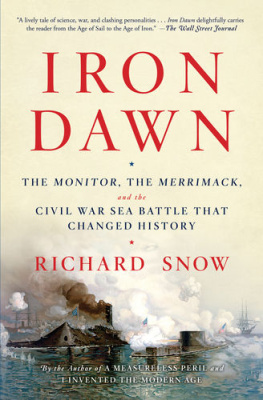Thank you for downloading this Scribner eBook.
Join our mailing list and get updates on new releases, deals, bonus content and other great books from Scribner and Simon & Schuster.
We hope you enjoyed reading this Scribner eBook.
Join our mailing list and get updates on new releases, deals, bonus content and other great books from Scribner and Simon & Schuster.
A Measureless Peril: America in the Fight for the Atlantic, the Longest Battle of World War II
The Monitor and the Merrimack . The ironclads are not drawn to relative scale: the Union ship was 179 feet long with a 411/2-foot beam; the Confederate, 275 feet by 51 feet.

SCRIBNER
An Imprint of Simon & Schuster, Inc.
1230 Avenue of the Americas
New York, NY 10020
www.simonandschuster.com
Copyright 2016 by Richard Snow
All rights reserved, including the right to reproduce this book or portions thereof in any form whatsoever. For information, address Scribner Subsidiary Rights Department, 1230 Avenue of the Americas, New York, NY 10020.
First Scribner hardcover edition November 2016
SCRIBNER and design are registered trademarks of The Gale Group, Inc., used under license by Simon & Schuster, Inc., the publisher of this work.
For information about special discounts for bulk purchases, please contact Simon & Schuster Special Sales at 1-866-506-1949 or .
The Simon & Schuster Speakers Bureau can bring authors to your live event. For more information or to book an event, contact the Simon & Schuster Speakers Bureau at 1-866-248-3049 or visit our website at www.simonspeakers.com.
Interior design by Kyle Kabel
Jacket design by Greg Mollica
Jacket image Archive Images/Alamy Stock Photo
Library of Congress Cataloging-in-Publication Data
Names: Snow, Richard, 1947author.
Title: Iron dawn : the Monitor , the Merrimack , and the Civil War sea battle that changed history / Richard Snow.
Description: First Scribner hardcover edition. | New York : Scribner, 2016.
Identifiers: LCCN 2016006965
Subjects: LCSH: Hampton Roads, Battle of, Va., 1862. Monitor (Ironclad) | Virginia (Ironclad)
Classification: LCC E473.2 .S67 2016 | DDC 973.7/31dc23
LC record available at http://lccn.loc.gov/2016006965
ISBN 978-1-4767-9418-1
ISBN 978-1-4767-9420-4 (ebook)
Interior and insert illustration credits: pages : Prints & Photographs Division, Library of Congress. The portrait of Lincoln in the insert is from the Mellon Collection. Other images are in the authors collection; many of the engravings appeared in two highly popular publications of the era, Frank Leslies Illustrated Newspaper and Harpers Weekly.
To the memory of my father and mother: Richard B. Snow, who served in the Atlantic aboard a latter-day ironclad during another war; and Emma Folger Snow, who endured those years of separation with the same lonely tenacity that he did
The sinking of all the worlds old sea-bitten names,
Temeraire , Victory , and Constellation ,
Serapis , Bon Homme Richard , Golden Hind ,
Galleys of Antony, galleys of Carthage,
Galleons with gilded Virgins, galleasses,
Viking long-serpents, siren-haunted galliots,
Argos and argosies and the Achaean pride,
Moving to sea in one long wooden wall
Behind the huge ghost-flagship of the Ark
In such a swelling cloud of phantom sail
They whitened Oceangoing down by the head,
Green water seeping through the battened ports,
Spreading along the scrubbed and famous decks,
Going downgoing downgoing downto mermaid-pools,
To Fiddlers Greento the dim barnacle-thrones,
Where Davy Jones drinks everlasting rum
With the sea-horses of his sunken dreams.
Stephen Vincent Bent John Browns Body
Contents
CHAPTER 1
Terrible Havoc: March 1862
One of a galaxy of patriotic tokens and medals struck in honor of the Union ironclad.
H er creator had come up with the name Monitor and he meant it to have the broadest implications. Not only was his ship to cast her stern gaze on all Southern deviltry, but there are other leaders who will also be startled and admonished by the booming of the guns from the impregnable iron turret. These leaders, he said, dwelt in Downing Street, London.
But neither the rebellious South nor the Lords of the Admiralty would have felt much admonished had they seen the USS Monitor on her maiden voyage.
It wasnt a long trip, just from Brooklyn down to the Chesapeake Bay, but during the journey she had nearly sunk twice in twenty-four hours. She had no business being out on the open sea in early March when the Atlantic is full of brutal caprice; she should still have been making cautious trial river voyages near the yard in Greenpoint where shed been built. Workmen had been hammering away at her iron skin right up to the time she raised anchor and steamed down through the Narrows of New York Harbor and out into the ocean.
The first few days of her life were encouraging. She hadnt sunk like an anvil, as many had predicted, and after some adjustments she went in the direction the helmsman wanted. The few inches of freeboard stayed above water, and the deck remained dry once she got to sea. Soon enough, though, a gale was kicking her around, and nothing about her was dry, inside or out, and most of her crew, with no sails to set or ropes to haul, could only brace themselves against sweating metal bulkheads in a drizzling darkness falteringly lit by oil lamps and engine fires. They could all feel the sea, but none of them could see it because they were sealed in below the waterlinein a submarine, really, although the word did not yet exist to describe a kind of boat. They were sailors, they knew the ocean and its ways, but this duty was new to them. Theyd never sailed in a ship like this one. Nobody had.
The captain got seasickno shame in that; Lord Nelson always had at the start of his voyagesand then many of the men did too. They were helped topside to lie, sketchily shielded from the spray by canvas sheets, on the only part of their ship that was above water now: the turret (although this was so new a development that many of them called it the tower). Below inside it were the gunsonly two of them, and all but untried. They were good cannon, big seven-ton Dahlgrens, but their inventor, Major John Dahlgren, wished theyd never left port. There hadnt been time to test them properly, and it seemed likely there wouldnt be until they were fired in battle.
The prospect of that battle was what had brought the Monitor and its men, half-trained and ill prepared, out into the March Atlantic. Some four hundred miles to the south, in Norfolk, Virginia, the Rebels were buildinghad builta vessel sheathed in iron. Unlike the Monitor , its upperworks rested on a wooden hull; it wasnt all iron. But what showed above the waterline was, and the vessels guarding the immense natural harbor of Hampton Roads, and thus Chesapeake Bay, the finest ships in the Union fleet, were all made of wood.

















